Unit - 1
DC Circuits
Resistor

V=IR
P=I2R

Behaviour of Resistance:
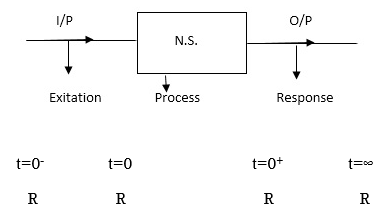
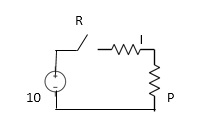
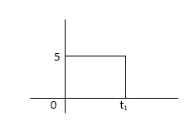
Inductor
- Active - FET, diode
- Passive - R, L, C
Storage of energy
Based on electromagnetic induction
Faraday’s Law
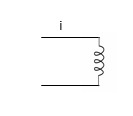
Φ∝i
Φ = L.i












Capacitor:
Charge storing device (voltage)
Q ∝ V
Q = C V






Electrostatic Energy

Inductor do not respond any change as far as current is concerned.
Capacitor does not respond any change as far as voltage is concerned.
Definition of Open circuit and short circuit
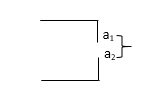
R=∞
V=0 or V≠ 0
I=0
Short Circuit:
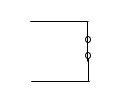
V = 0
R = 0
I may or may not be zero
Categories of sources
- Voltage source and current source
- A.C. Source and D.C. Source
- Dependent source and independent source
- Constant and function of time source
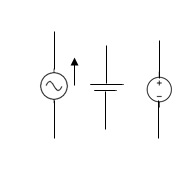
Few either
AC or DC 
Dc

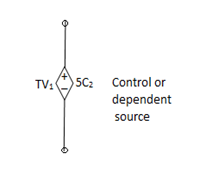
Equivalent circuit diagram of
- Voltage Source: A voltage source always have a resistance in series.
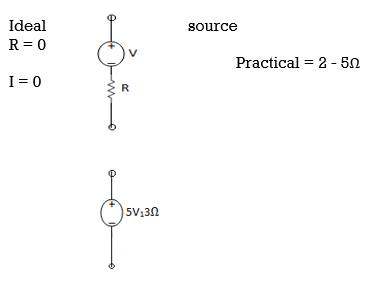
2. Current Source: Always have R parallel with the source.
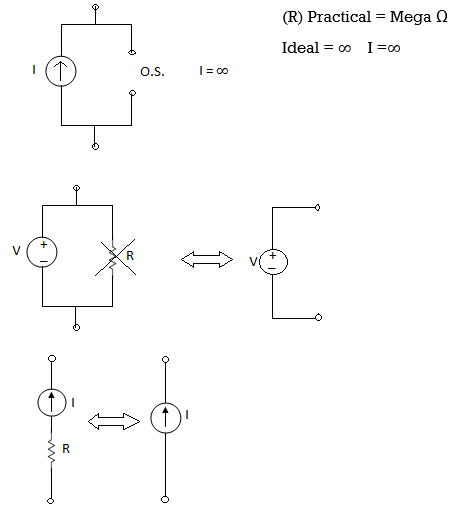
Ideal and Practical Sources (Independent Sources only)
Ideal and practical Voltage and Current source:
A voltage source is a device which provides a constant voltage to load at any instance of time and is independent of the current drawn from it. This type of source is known as an ideal voltage source. Practically, the ideal voltage source cannot be made. It has zero internal resistance. It is denoted by this symbol.
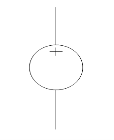
Fig: Voltage source symbol
Ideal Voltage Source
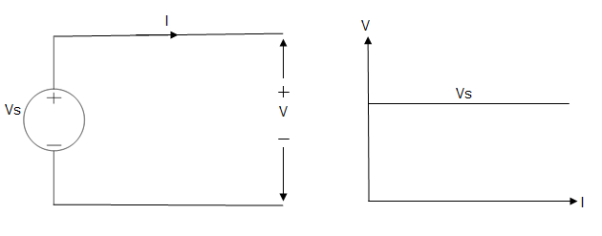
Fig: Ideal Voltage Source
The graph represents the change in voltage of the voltage source with respect to time. It is constant at any instance of time.
Voltage sources that have some amount of internal resistance are known as a practical voltage source. Due to this internal resistance, voltage drop takes place. If the internal resistance is high, less voltage will be provided to load and if the internal resistance is less, the voltage source will be closer to an ideal voltage source. A practical voltage source is thus denoted by a resistance in series which represents the internal resistance of source.
Practical Voltage source
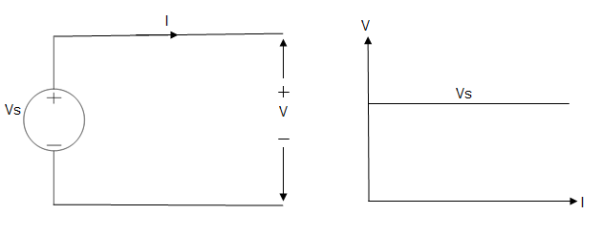
Fig: Practical Voltage source
The graph represents the voltage of the voltage source with respect to time. It is not constant but it keeps on decreasing as the time passes.
Current source
A current source is a device which provides the constant current to load at any time and is independent of the voltage supplied to the circuit. This type of current is known as an ideal current source; practically ideal current source is also not available. It has infinite resistance. It is denoted by this symbol.
Ideal Current source
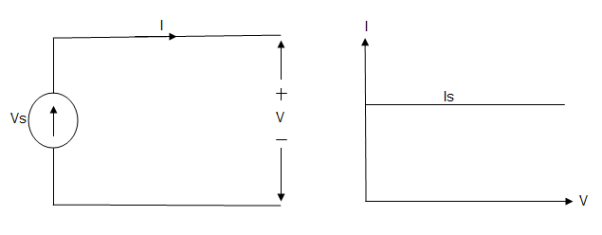
Fig: Ideal Current source
The graph represents the change in current of the current source with respect to time. It is constant at any instance of time.
Why ideal Current source has infinite resistance?
A current source is used to power a load, so that load will turn on. We try to supply 100% of the power to load. For that, we connect some resistance to transfer 100% of power to load because the current always takes the path of least resistance. So, in order for current to go to the path of least resistance, we must connect resistance higher than load. This is why we have the ideal current source to have infinite internal resistance. This infinite resistance will not affect voltage sources in the circuit.
Practical Current source
Practically current sources do not have infinite resistance across there but they have a finite internal resistance. So the current delivered by the practical current source is not constant and it is also dependent somewhat on the voltage across it.
A practical current source is represented as an ideal current source connected with resistance in parallel.
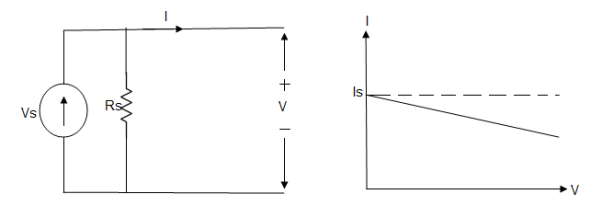
Fig; Practical Current source
The graph represents the current of the current source with respect to time. It is not constant but it also keeps on decreasing as the time passes.
The algebraic sum of currents meeting at a junction or node in a electric circuit is zero or the summation of all incoming current is always equal to summation of all outgoing current in an electrical network.
Explanation
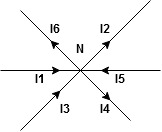
Assuming the incoming current to be positive and outgoing current negative we have



i.e incoming current = ∑ outgoing current thus, the above Law can also be stated as the sum of current flowing towards any junction in an electric circuit is equal to the sum of currents flowing away from that junction
incoming current = ∑ outgoing current thus, the above Law can also be stated as the sum of current flowing towards any junction in an electric circuit is equal to the sum of currents flowing away from that junction
Kirchhoff’s Voltage Law (KVL)
Statement: the algebraic summation of all Voltage in any closed circuit or mesh of loop zero. Ie ∑ Voltage in closed loop = 0 the summation of the Voltage rise (voltage sources) is equal to summation of the voltage drops around a closed loop in 0 circuit for explanation from here determination of sigh and direction of currents (Don’t write in exams just for understanding)

Current entering a resistor is +ve and leaving should be –ve
Now
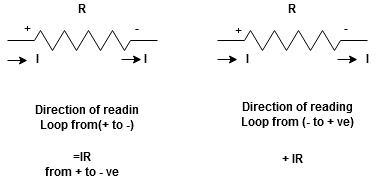


Potential Rise Potential Drop
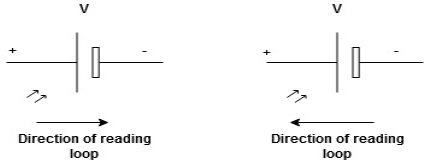
We are reading from +V to –V we are reading from –V to +V
 potential drops
potential drops  potential rise
potential rise
 -V
-V  +V
+V
Given Circuit
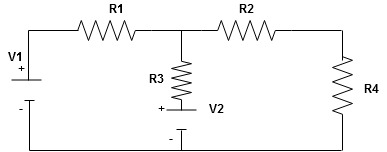
First identify no of loops and assign direction of current flowing in loop
Note: no of loops in circuit = No, of unknown currents = no, of equations in the circuit
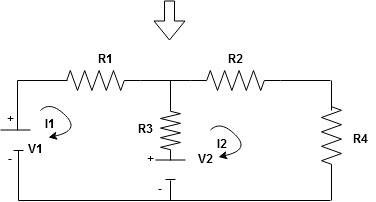
Note: keep loop direction and current direction same ie either clockwise or anticlockwise for all loops I1 I2
Now according to direction of direction assign signs (+ve to –ve) to the resistors
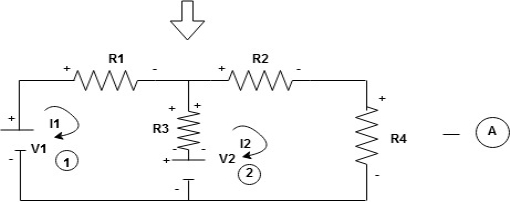
Note: voltage sources (V) polarities does not change is constant.
Note: for common resistor between 2 loops appearing in the circuit like R3 give signs according to separate loops as shown

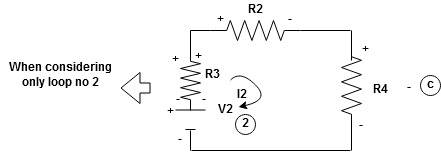
Now consider diagram A and write equations
Two loops  two unknown currents
two unknown currents  two equation
two equation
Apply KVL for loop ① [B. Diagram ]
(+ to drop -) = - sign and (- to rise +) = + sign
 for drop = -sign
for drop = -sign
 for rise = + sign
for rise = + sign
-
-( ) R2 is considered because in R3,2 currents are flowing
) R2 is considered because in R3,2 currents are flowing  and
and  and we have taken (
and we have taken ( ) because we are considering loop no 1 and current flowing is
) because we are considering loop no 1 and current flowing is  in loop no 1
in loop no 1
 )
)
Similarly for loop no. 2 currents flowing is  resistor R3 it should be
resistor R3 it should be  )R3
)R3
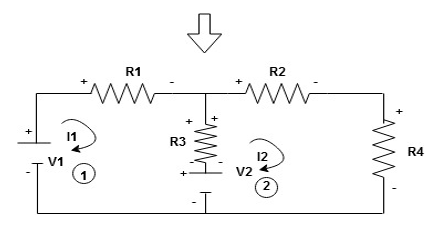
Consider loop no. 1 apply KVL
- …….①
…….①
-
Consider loop no. 2 apply KVL
- …….②
…….②
-
After solving equation ① and ② we will get branch current  and
and 
Superposition Theorem:
This theorem states that in a linear network containing several independent sources, the overall response at any point in the network equals the sum of responses due to each independent source considered separately with all other independent sources made inoperative.
- This is only applicable to circuits with linear elements.
- If two or more than two independent sources (voltage or current) are operating in the circuit then the voltage across any element or current through any element is the sum of current and voltages due to individual sources.
Question 1. Find the current through  resistance.
resistance.
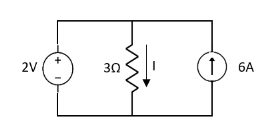
Fig: Circuit Diagram
Solution:
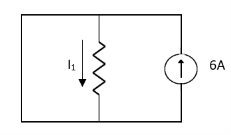
Fig: Short circuit 2V
 1 = 0
1 = 0
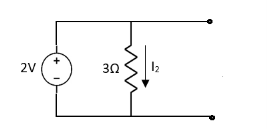
Fig: Open circuit 6A
 2 =
2 =
 1 +
1 +  2
2 
Key takeaway
Special Case
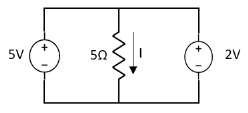
Fig: Circuit with two voltage sources
Since two voltage sources with different magnitudes in parallel cannot be connected as in a single branch, two different currents are not possible (if 5V then I = zero).
Question 2: Find Value of current I
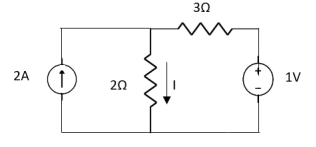
Fig: Circuit Diagram
Sol: Applying Superposition Theorem
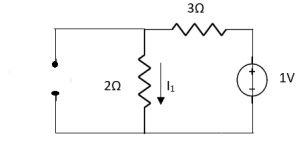
Fig: Circuit with 2A open circuit
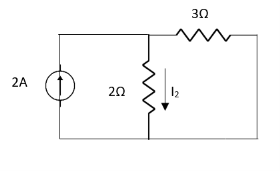
Fig: Circuit with 1V short circuit
 1 =
1 = 
 2 =
2 = 
=
 1 +
1 +  2
2
= 
Thevenin’s And Norton’s Theorem
Thevenin’s Theorem states that a two-terminal network containing sources and passive elements is equivalent to a voltage source in series with the network impedance with all independent sources removed.

Fig: Two-port network
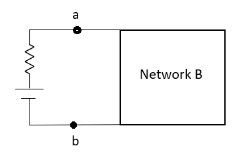
Fig: Thevenin’s equivalent of A
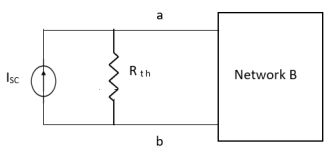
Fig: Norton’s equivalent of A
Norton’s Theorem states that a two-terminal network containing sources and passive elements is equivalent to an independent current source in parallel with the network impedance with all independent sources removed. The current of the current source has the same magnitude and reference direction as that of the current which would exist at the terminal in the original network if the terminals were short-circuited.
The short circuit current is then given as
 sc = Vth/Rth
sc = Vth/Rth
Norton’s equivalent is obtained by source conversion of Thevenin’s equivalent circuit.
CONDITIONS FOR APPLICATION
- For network A:
- Network A should contain linear elements.
- Network A can have independent and dependent current and voltage sources.
- If network A has a dependent source then the controlling parameter must lie in network A itself.
- Network A should not have any source coupling and magnetic coupling.
- For network B:
- It can have linear and non-linear elements.
- It can have dependent and independent voltage and current sources.
- It should not have any source and magnetic coupling with network A.
Method for finding Rth:
Firstly, open circuit terminal A and B.
- If the network is operating with only independent sources:
- Make all sources zero in network A.
- Find out the equivalent resistance across terminals A and B.
2. If network A is operating with independent and dependent sources:
- Make all independent sources zero in network A.
- Connect a generation between A and B.
3. If the network is operating with only dependent sources:
Connect generation between A and B

Method for Vth:
First, open circuit terminal A and B.
Find out the voltage between A and B this is Vth
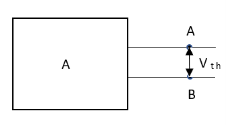
Fig: Terminal where we find Vth
Method for Isc:
- Isc =

- Remove network B and S.C. The terminal A and B and current from terminal A to B Isc.
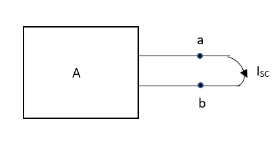
Fig: Finding Isc
Question: Find Vth and Rth for the circuit shown below?
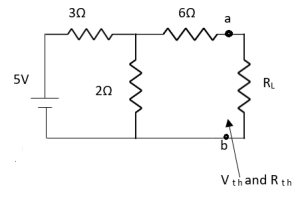
Fig: Circuit Diagram
Answer:
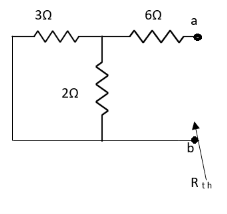
Fig: Circuit for finding Rth



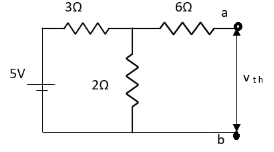
Fig: Finding Vth across a and b


Finding Isc from circuit directly:
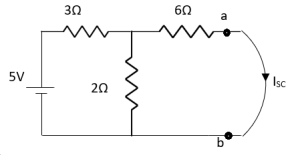
Fig: Finding Isc
By KCL,




Question: Find Vth and Rth across a and b?
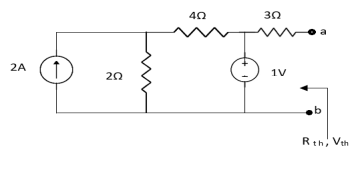
Fig: Circuit Diagram
Sol: Finding Rth
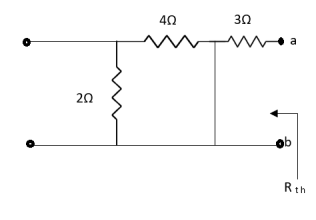
Fig: Circuit for Rth
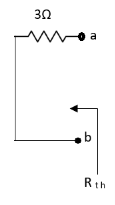
Also, clear from circuit that Vth = 1V.
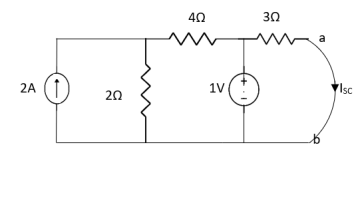
Fig: Circuit for Isc
By applying KVL we get,
1-3Isc=0
Isc= A
A
Que: Find Isc and Rth across terminal a and b?
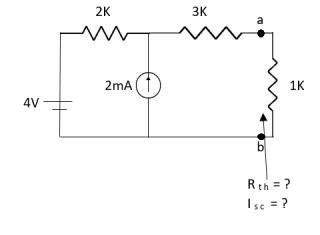
Fig: Circuit Diagram
Ans;
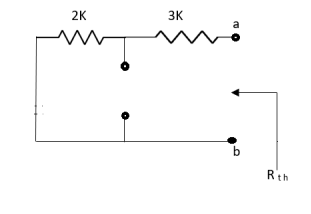
Fig: Circuit for finding RTh
Rth=3k+2k=5k
By applying KVL we get





Therefore, 
Question: Find the value of voltage Vx?
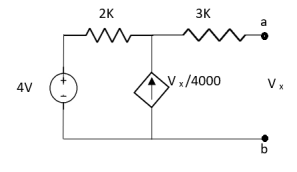
Fig: Circuit Diagram
Solution: For Rth
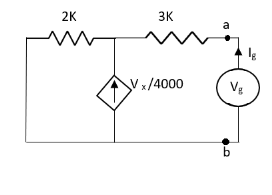
Fig: Circuit for finding Rth
By KCL,



But, 








By KVL,




Question: Find value of current I in the circuit?
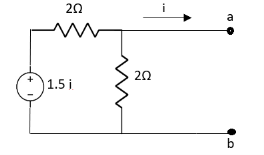
Fig: Circuit diagram
Solution: Since, no independent source is present so,
Isc = 0
And we know that,


Since Rth cannot be zero
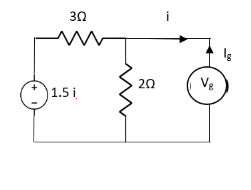
Fig: Circuit for finding Rth



But 


Question: Find out the Norton’s equivalent
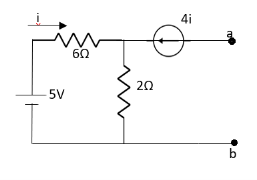
Fig: Circuit diagram
Solution:
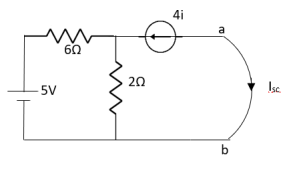
Fig: Circuit for finding Isc
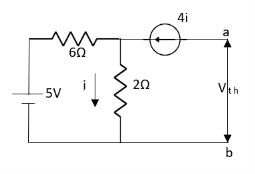
Fig: Circuit for finding Vth

Since, there is no significance of current source





 A
A
FOR RL Circuit
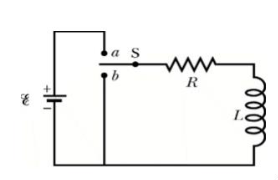
Fig: Series RL circuit
After switch is closed applying KVL
 =0
=0
This is first order homogeneous differential equation so
 dt
dt
Integrating both sides
Ln i=  t+K
t+K
Taking antilog of both sides
i=k
At t=0
i(0)= =I0
=I0
 =ke0
=ke0
The particular solution is given as
i=  for t≥0
for t≥0
= for t<0
for t<0
FOR RC Circuit
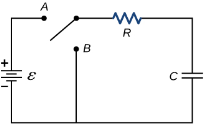
Fig: Series RC circuit
 =V
=V
For t>0 applying KVL
Ri(t)+ +V=0
+V=0

Hence general solution of above equation is calculated same as for RL circuit
i=k
i(0)=- 
Hence, particular solution for network is given as
i=-  for tfor t≥0
for tfor t≥0
= for t<0
for t<0
Time Constant
Time constant for RL circuit
From above section for RL circuit at t≥0
i= 
i=I0
I0= 

Time taken for current to drop from unity to zero is called as time constant T.

 sec
sec
FOR RC Circuit
It can be calculated in the same manner as for series RL circuit
The time constant is given as 
T=RC
References:
- D. P. Kothari and I. J. Nagrath, “Basic Electrical Engineering”, Tata McGraw Hill, 2010.
- D. C. Kulshreshtha, “Basic Electrical Engineering”, McGraw Hill, 2009.
- L. S. Bobrow, “Fundamentals of Electrical Engineering”, Oxford University Press, 2011.
- E. Hughes, “Electrical and Electronics Technology”, Pearson, 2010.
- V. D. Toro, “Electrical Engineering Fundamentals”, Prentice Hall India, 1989.